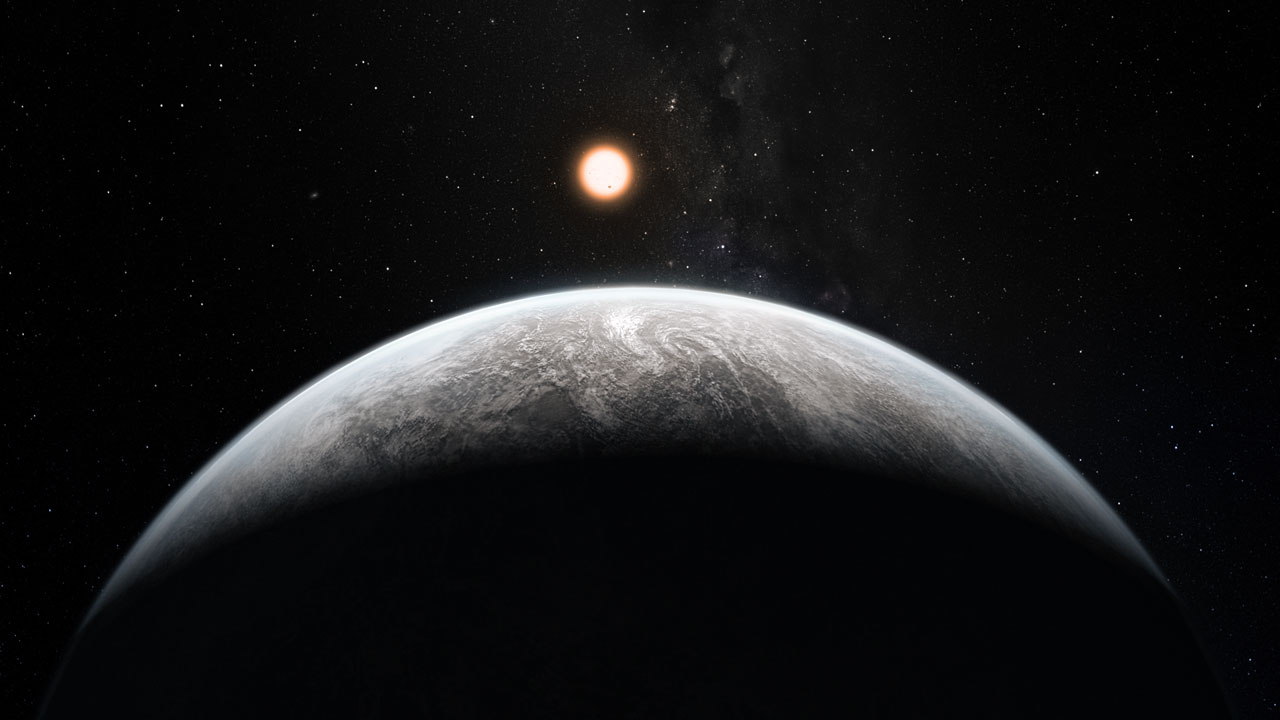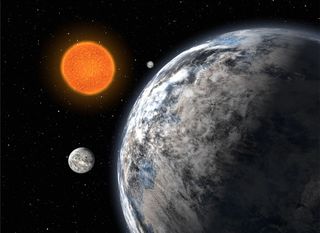Super-Earth or Mini-Neptune? New Technique to Probe Exoplanet Habitability

Perhaps the most intriguing exoplanets found so far are those bigger than our rocky, oceanic Earth but smaller than cold, gas-shrouded Uranus and Neptune. This mysterious class of in-between planets —alternatively dubbed super-Earthsor mini-Neptunes — confounds scientists because nothing like them exists as a basis for comparison in our solar system.
"We don't really know what they are," said Björn Benneke, a graduate student in astronomy at the Massachusetts Institute of Technology. "They can be a scaled-down version of the giant planets in our solar system, a scaled-up version of terrestrial planets like Earth or something completely different."
Benneke is co-author of a paper accepted by the Astrophysical Journal that attempts to solve this vexing riddle. Based on numerical computer models, he developed an observational strategy that would let astronomers distinguish between two very different types of atmospheresassociated with these planets. Learning about their atmospheres will speak to the overall nature of these heretofore unknowable worlds with masses ranging up to about 10 times that of Earth. (Uranus and Neptune have 14 and 17 Earth-masses, respectively.) [The Strangest Alien Planets (Gallery)]
A tale of two atmospheres
The first scenario is an atmosphere dominated by hydrogen and helium, like that of Uranus and Neptune. The second is an atmosphere composed predominately of larger compounds, such as water vapor, carbon dioxide and nitrogen molecules, like Earth, or carbon monoxide and methane, among others.
The essential difference between these two scenarios goes beyond satisfying mere curiosities of planetary science. Figuring out if an exoplanet is more like Neptune or more like Earth drives at one of the core conceits of all astronomical work: the search for alien life.
Lacking a rocky surface and oceans, a gaseous mini-Neptune would not be hospitable to life as we know it. On the other hand, a super-Earth with water and other biologically enabling chemistries could serve as a thriving extraterrestrial abode.
Get the Space.com Newsletter
Breaking space news, the latest updates on rocket launches, skywatching events and more!
Crucially, the discernment between mini-Neptunes and super-Earths as proposed by Benneke can be done with available telescopes. Astronomers and the public will therefore not have to wait until next-generation instruments such as NASA's James Webb Space Telescope come online later this decade.
"What is nice about this is that the proposed observations are possible with current instruments," he said. "They would represent the first observational baby step to saying something definitive about what the conditions are on these planets."
Benneke and colleagues at the University of Chicago have in fact already been allotted observational time with NASA's iconic Hubble Space Telescope to stare long and hard at the exoplanet GJ 1214b. They hope to apply their mathematical approach and be able to state, even as soon as this year, what the basic character of this world is. [Latest Photos from the Hubble Space Telescope]
Scientists have debated over GJ 1214b since the planet was discovered back in 2009. Based on its size and mass—2.8 Earth radii and 6.6 Earth masses—GJ 1214b could be covered in oceans hundreds of miles deep, or a thick envelope of hydrogen and helium gas might instead surround its rocky core.

Sniffing out an atmosphere
Benneke's concept for characterizing atmospheres relies on planetary transits, which is when an exoplanet crosses in front of the star as seen from Earth and blocks some of the star light during this transit.
NASA's Kepler mission has looked at more than 150,000 stars for this slight dimming effect that reveals the presence of planets and some of their basic properties. Other space telescopes, such as Hubble and the Spitzer Space Telescope, also make use of this technique.
When a transit occurs, starlight shines through the exoplanet's atmosphere. Different wavelengths of light preferentially pass through this atmosphere based on its composition, thickness, cloud content and so on.
By simultaneously measuring how much the star becomes fainter during the planet's transit at different wavelengths, the general extent of the planet's atmosphere and by extension its chemical character can be inferred.
Benneke found that while it is possible to infer the presence of gases like water vapor and carbon dioxide from this spectrum, determining the relative amounts of the gases is trickier. Puffy, hydrogen-rich atmospheres with a minute amount of water vapor and high-altitude clouds can display water absorption features of the same strength as atmospheres made entirely of water vapor.
Fortunately, visualizing the data can help. When the transmission spectrum is plotted on a graph, the steepness of the absorption features can be a tell-tale sign of the amount of the atmosphere's constituents. "When graphed, the spectrum of water-rich atmosphere appears wavier, but hydrogen-rich atmosphere show more distinct and spiky signatures," said Benneke. "This difference is unambiguous."
Effectively, the technique can be used to measure the average mass of the molecules in the exoplanet's atmosphere. And conveniently for the purposes of distinguishing a hydrogen-dominated atmosphere from a watery one, say, the molecular masses are strikingly different.
Benneke offered an example. The average molecular mass for one of these super-Earth or mini-Neptune candidates could turn out to be about 18, say. Right away, Benneke said, such a figure would rule out a hydrogen-dominated atmosphere, the value of which would come in closer to two based on the mass of a hydrogen molecule, H2. Hydrogen consists of a single proton, which has a representative mass of one on the periodic table. (The electron associated with hydrogen has negligible mass.) A water molecule, H2O, has an atomic mass of 18 per the addition of oxygen's eight protons and eight neutrons. (Protons and neutrons have nearly the same mass and so register as one apiece in this calculation.)
"If we know the molecular mass is 18, we can already say the atmosphere can't be hydrogen-dominated," said Benneke. "On the opposite side, if it's somewhere around two or three, then we would know the planet must be like Neptune." [Photos of Neptune, the Mysterious Blue Planet]
Putting exoplanets to the test
GJ 1214b stands as the ideal test case for Benneke's concept. The exoplanet tightly orbits a very small, dim star. Accordingly, the planet frequently crosses the face of its star from our vantage point, offering astronomers plenty of data points. Furthermore, the planet's transits block a relatively large amount of its host star's light, providing astronomers a stronger signal with which to parse its atmosphere. "GJ 1214b as the first test case is by far the easiest to do," said Benneke.

His technique could work for other transiting super-Earth and mini-Neptune candidates, some of which will sound familiar to exoplanet fans, including HD 97658b, 55 Cancri e, and GJ 436b.
The density of these worlds, like GJ 1214b, requires them to have more rocky or icy content than Uranus and Neptune, but not to be completely made of rock like Earth. Answering the question about whether the remainder of their composition is hydrogen and helium or life-friendly gases such as water vapor, carbon dioxide and nitrogen, will require substantially more observing time than for GJ 1412b, Benneke said, but is not impossible.
"We will be able to learn something about the atmospheres of those planets, and from there if they have a surface or if they are just some kind of gas giant," said Benneke. "There have been a lot of theoretical ideas of what these planets could be that would explain their mass and radius, but there hasn't been really an explanation of how we can unambiguously distinguish between the two scenarios of super-Earth and mini-Neptune, until now."
This story was provided by Astrobiology Magazine, a web-based publication sponsored by the NASA astrobiology program.
Follow us @Spacedotcom, Facebook or Google+. Published on SPACE.com.
Join our Space Forums to keep talking space on the latest missions, night sky and more! And if you have a news tip, correction or comment, let us know at: community@space.com.

Adam Hadhazy is a contributing writer for Live Science and Space.com. He often writes about physics, psychology, animal behavior and story topics in general that explore the blurring line between today's science fiction and tomorrow's science fact. Adam has a Master of Arts degree from the Arthur L. Carter Journalism Institute at New York University and a Bachelor of Arts degree from Boston College. When not squeezing in reruns of Star Trek, Adam likes hurling a Frisbee or dining on spicy food. You can check out more of his work at www.adamhadhazy.com.
